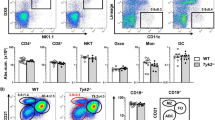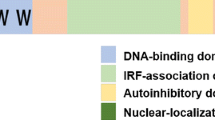Abstract
This study analysed the biological significance of TLT-2 on CD8+T cells in hepatitis B patients and provided a theoretical basis for the potential role of TLT-2 as an immune regulator. Flow cytometry sorting, isobaric tags for relative and absolute quantitation and short hairpin RNAs were used to analyse the function of TLT-2 on CD8+T cells in hepatitis B patients. The TLT-2 expression levels in the acute hepatitis B and chronic hepatitis B groups were significantly higher than that in the healthy control group and were positively correlated with ALT and AST. The CD8+TLT-2+T cells exhibited stronger immune function and greater cell proliferation ability and secreted higher levels of cytokines than the CD8+TLT-2−T cells. An analysis of the proteome differences between the TLT-2+CD8+T and TLT-2−CD8+T cells revealed that TLT-2 affected CD8+T cell activation by regulating Granzyme B expression and by further action on the NF-κB signalling pathway. This study first elucidated the mechanism by which TLT-2 influences the activation of CD8+T cells, improved the understanding of the TLT-2 signalling pathway and clarified the role of the TLT-2+CD8+T cell subset in hepatitis B virus infection. The study proposed a novel subset of CD8+T cells that could be useful for understanding the immune function of patients with hepatitis B and further elucidating the pathogenesis of hepatitis B by analysing changes in this subpopulation with the goal of providing a new target for the treatment of hepatitis B.





Similar content being viewed by others
Abbreviations
- HBV:
-
Hepatitis B virus
- TREM:
-
Triggering receptors expressed by myeloid cells
- TLT-2:
-
Trem (triggering receptor expressed on myeloid cells)-like transcript 2
- HC:
-
Healthy controls
- AHB:
-
Acute hepatitis B
- CHB:
-
Chronic hepatitis B
- HBV-LC:
-
Hepatitis B virus-associated liver cirrhosis
- HBV-HCC:
-
Hepatitis B virus-associated hepatocellular carcinoma
- ALT:
-
Alanine aminotransferase
- AST:
-
Aspartate aminotransferase
- TBIL:
-
Total bilirubin
- ALB:
-
Albumi
- α-TNF:
-
Tumor necrosis factor α
- CT:
-
Computed tomography
- MRI:
-
Magnetic resonance imaging
- HBeAg:
-
Hepatitis B e-antigen
- PBMCs:
-
Peripheral blood mononuclear cells
- SSC:
-
Side scatter
- FSC:
-
Forward scatter
- iTRAQ:
-
Isobaric tags for relative and absolute quantitation
- LC–MS/MS:
-
Liquid chromatography coupled to tandem mass spectrometry
- GO:
-
Gene ontology
- NF-κB:
-
Nuclear factor kappa-light-chain-enhancer of activated B cells
- NFAT:
-
Nuclear factor of activated T cells
- AP-1:
-
Activator protein 1
- PMA:
-
Phorbol-12-myristate-13-acetate
- BID:
-
BH3 interacting-domain death agonist
- ns:
-
Not significant
- shRNA:
-
Short hairpin RNA
References
Kamei K, Yasuda T, Ueda T, Qiang F, Takeyama Y, Shiozaki H. Role of triggering receptor expressed on myeloid cells-1 in experimental severe acute pancreatitis. J Hepatobiliary Pancreat Sci. 2010;17(3):305–12.
Ott JJ, Stevens GA, Groeger J, Wiersma ST. Global epidemiology of hepatitis B virus infection: new estimates of age-specific HBsAg seroprevalence and endemicity. Vaccine. 2012;30(12):2212–9.
Nathan C, Ding A. TREM-1: a new regulator of innate immunity in sepsis syndrome. Nat Med. 2001;7(5):530–2.
Ormsby T, Schlecker E, Ferdin J, et al. Btk is a positive regulator in the TREM-1/DAP12 signaling pathway. Blood. 2011;118(4):936–45.
Bouchon A, Hernández-Munain C, Cella M, Colonna M. A DAP12-mediated pathway regulates expression of CC chemokine receptor 7 and maturation of human dendritic cells. J Exp Med. 2001;194(8):1111–22.
Daws MR, Sullam PM, Niemi EC, Chen TT, Tchao NK, Seaman WE. Pattern recognition by TREM-2: binding of anionic ligands. J Immunol. 2003;171(2):594–9.
Washington AV, Schubert RL, Quigley L, et al. A TREM family member, TLT-1, is found exclusively in the alpha-granules of megakaryocytes and platelets. Blood. 2004;104(4):1042–7.
Washington AV, Quigley L, McVicar DW. Initial characterization of TREM-like transcript (TLT)-1: a putative inhibitory receptor within the TREM cluster. Blood. 2002;100(10):3822–4.
Ford JW, McVicar DW. TREM and TREM-like receptors in inflammation and disease. Curr Opin Immunol. 2009;21(1):38–46.
Xu JC, Gao F, Fu FQ, et al. Generation and characterization of two novel monoclonal antibodies produced against human TLT-2 molecule. Monoclon Antib Immunodiagn Immunother. 2013;32(3):216–23.
King RG, Herrin BR, Justement LB. Trem-like transcript 2 is expressed on cells of the myeloid/granuloid and B lymphoid lineage and is up-regulated in response to inflammation. J Immunol. 2006;176(10):6012–21.
Kobori H, Hashiguchi M, Piao J, Kato M, Ritprajak P, Azuma M. Enhancement of effector CD8+ T-cell function by tumour-associated B7-H3 and modulation of its counter-receptor triggering receptor expressed on myeloid cell-like transcript 2 at tumour sites. Immunology. 2010;130(3):363–73.
Halpert MM, Thomas KA, King RG, Justement LB. TLT2 potentiates neutrophil antibacterial activity and chemotaxis in response to G protein-coupled receptor-mediated signaling. J Immunol. 2011;187(5):2346–55.
Hashiguchi M, Kobori H, Ritprajak P, Kamimura Y, Kozono H, Azuma M. Triggering receptor expressed on myeloid cell-like transcript 2 (TLT-2) is a counter-receptor for B7-H3 and enhances T cell responses. Proc Natl Acad Sci USA. 2008;105(30):10495–500.
Leitner J, Klauser C, Pickl WF, et al. B7-H3 is a potent inhibitor of human T-cell activation: no evidence for B7-H3 and TREML2 interaction. Eur J Immunol. 2009;39(7):1754–64.
Zhang G, Wang J, Kelly J, et al. B7-H3 augments the inflammatory response and is associated with human sepsis. J Immunol. 2010;185(6):3677–84.
Prasad DV, Nguyen T, Li Z, et al. Murine B7-H3 is a negative regulator of T cells. J Immunol. 2004;173(4):2500–6.
Suh WK, Gajewska BU, Okada H, et al. The B7 family member B7-H3 preferentially down-regulates T helper type 1-mediated immune responses. Nat Immunol. 2003;4(9):899–906.
Zhang G, Xu Y, Lu X, et al. Diagnosis value of serum B7-H3 expression in non-small cell lung cancer. Lung Cancer. 2009;66(2):245–9.
Vigdorovich V, Ramagopal UA, Lázár-Molnár E, et al. Structure and T cell inhibition properties of B7 family member, B7-H3. Structure. 2013;21(5):707–17.
Carrasquillo MM, Allen M, Burgess JD, et al. A candidate regulatory variant at the TREM gene cluster associates with decreased Alzheimer’s disease risk and increased TREML1 and TREM2 brain gene expression. Alzheimers Dement. 2017;13(6):663–73.
Zheng H, Liu CC, Atagi Y, et al. Opposing roles of the triggering receptor expressed on myeloid cells 2 and triggering receptor expressed on myeloid cells-like transcript 2 in microglia activation. Neurobiol Aging. 2016;42:132–41.
Ghani M, Sato C, Kakhki EG, et al. Mutation analysis of the MS4A and TREM gene clusters in a case–control Alzheimer’s disease data set. Neurobiol Aging. 2016;42:217.e7–13.
Benitez BA, Jin SC, Guerreiro R, et al. Missense variant in TREML2 protects against Alzheimer’s disease. Neurobiol Aging. 2014;35(6):1510.e19–26.
de Freitas A, Banerjee S, Xie N, et al. Identification of TLT2 as an engulfment receptor for apoptotic cells. J Immunol. 2012;188(12):6381–8.
Albers I, Hartmann H, Bircher J, Creutzfeldt W. Superiority of the Child–Pugh classification to quantitative liver function tests for assessing prognosis of liver cirrhosis. Scand J Gastroenterol. 1989;24(3):269–76.
Llovet JM, Brú C, Bruix J. Prognosis of hepatocellular carcinoma: the BCLC staging classification. Semin Liver Dis. 1999;19(3):329–38.
Afonina IS, Cullen SP, Martin SJ. Cytotoxic and non-cytotoxic roles of the CTL/NK protease granzyme B. Immunol Rev. 2010;235(1):105–16.
Huang C, Bi E, Hu Y, et al. A novel NF-kappaB binding site controls human granzyme B gene transcription. J Immunol. 2006;176(7):4173–81.
Acknowledgements
We thank all patients, clinicians and support staff who participated in this study.
Funding
This work was supported by Grants from the Science and Technology Plan of Suzhou, China (SYS201369 and SS201657), and the Health Plan of Jiangsu, China (H201652 and H2017068).
Author information
Authors and Affiliations
Corresponding authors
Ethics declarations
Conflict of interest
The authors declare that they have no conflict of interest.
Ethical approval
All procedures performed in studies involving human participants were in accordance with the ethical standards of the institutional and/or national research committee and with the 1964 Helsinki declaration and its later amendments or comparable ethical standards.
Informed consent
Informed consent was obtained from all individual participants included in the study.
Electronic supplementary material
Below is the link to the electronic supplementary material.
Rights and permissions
About this article
Cite this article
Xu, JC., Gao, F., Liu, YA. et al. Myeloid cell-like transcript 2 is related to liver inflammation and the pathogenesis of hepatitis B via the involvement of CD8+T cell activation. Clin Exp Med 19, 93–104 (2019). https://doi.org/10.1007/s10238-018-0534-1
Received:
Accepted:
Published:
Issue Date:
DOI: https://doi.org/10.1007/s10238-018-0534-1




